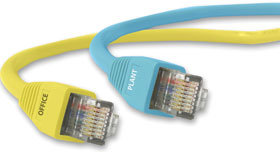

Connected Enterprise can bring greater productivity, better asset utilisation, faster problem solving and improved decision-making to industrial companies. It offers ease of use, lower total cost of ownership and improved operations.
Internet-enabled technology, industrial Ethernet, the cloud, big data and the Internet of Things (IoT) are supporting the Connected Enterprise concept that offers so much potential for improved operations. As a result, it’s crucial to protect the industrial control and information systems that comprise your infrastructure.
The proliferation of Internet-enabled devices and deployment of standard EtherNet/IP across control systems have the potential for delivering tremendous benefits to those taking advantage, and great competitive risks for those not preparing a strategic response. Enter the Connected Enterprise. It allows tremendous collaboration among people, plant-floor systems and enterprise applications to improve productivity and sustainability.
A Connected Enterprise means having access to real-time and historical data, wherever it is being produced, and all of the business and transactional data that will affect different plants and their operations. It involves seamlessly and securely connecting all control and information levels of an organisation.
“When we speak to our customers about moving a Connected Enterprise forward, it’s not unusual for them to raise two concerns: cost and security,” explains John Nesi, vice president, global market development, Rockwell Automation.
“By letting people know what’s really happening in the enterprise, the Connected Enterprise creates real customer value by turning data into information into knowledge and ultimately into wisdom,” says Keith Nosbusch, chairman and CEO, Rockwell Automation. This requires a common, secure Ethernet infrastructure to integrate and control information.
“That value opportunity comes directly from the technology opportunity. Having the technology and the knowledge to distil all of the business and transactional data into information that provides true innovative value, is the next frontier,” says Nesi.
A rising population, estimated to reach 8 billion, means increased demand for more goods, generating approximately $3,7-trillion in value in the manufacturing sector over the next decade. The next wave of productivity will come from the IoT – in 2020 we’ll have 50 billion things connected to the Internet. “But the big impact, the stunning opportunity here, is in industry,” says Rob Soderbery of Cisco. “When you can connect things, processes and data in the cloud, you can create new real-world applications in logistics, in segments that are upstream in the supply chain.”
Security at the forefront
Many challenges exist, from converging and merging disparate networks, to harvesting distributed intelligence by pushing analytics out to the data sources, to ease of use. However, according to Soderbery, the one that trumps them all is security. Unless you address those concerns, you cannot get started.
What makes IoT security different? One reason is the ‘attack surface’, the place an attack can be initiated. “The attack surface of a factory is large and complex. Remediation also is different. What do you do if you’re under attack in the process industry? Shutting down is not a practical or easy response,” says Soderbery.
He offers some ideas for IoT security. “Access control is more than a firewall. You have to be aware of the content on the network through tools like deep-packet-inspection engines. A second thing is the context. What’s the device, what data does it produce, is it where it says it is? You can draw some conclusions through the combination of content and context.”
“Companies such as equipment and machine builders themselves want access to the equipment they sold you, and want to understand the operating envelopes of those machines to help optimise them and help them perform safely,” says Mike Assante, advisor and director for the National Board of Information Security Examiners. “It’s time to adapt. We’re at an inflection point in the effectiveness of traditional defences.”
He says we have to secure our people first. “Automation engineers have to work with cyber-security personnel, and vice versa, to cross-educate their strengths and needs. This can lead to new approaches to better security. We’re setting up guidelines to help do that.”
Bringing the cloud down to earth
The cloud, big data and the IoT are real, and they’re already working in industrial settings. “We help users connect to their information, organise it, put it into the right context, set up dashboards and distribute it,” says Keith McPherson, market development director, Rockwell Software.
For example, a company makes use of a Rockwell Cloud-based solution and a Microsoft platform for its fracking trucks. Sensors and other field-based devices provide data via real-time production models to preconfigured software, which builds reports and displays. In some instances users can use iPads and Gmail to log in to their trucks, check actual data dashboards with real-time parameters and even initiate immediate orders for service or supplies. Rockwell Software offers a mobile app, which provides any KPIs users’ needs at their fingertips.
Rockwell Automation offers a pre-engineered, scalable infrastructure that lets users run multiple operating systems and applications on virtualised servers. It has the ability to run a virtualised PlantPAx system (Rockwell Automation’s process automation system) and a variety of third-party software packages on a user’s private cloud.
“We believe that we are at an inflection point drawn by the integration of the Internet of Things and the Connected Enterprise,” concludes Nosbusch.
For more information contact Christo Buys, Rockwell Automation, +27 (0)11 654 9700, [email protected], www.rockwellautomation.co.za
| Tel: | +27 11 654 9700 |
| Email: | [email protected] |
| www: | www.rockwellautomation.co.za |
| Articles: | More information and articles about Rockwell Automation |

© Technews Publishing (Pty) Ltd | All Rights Reserved